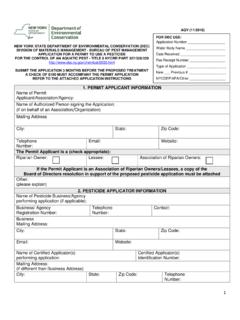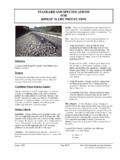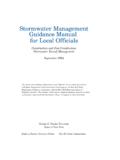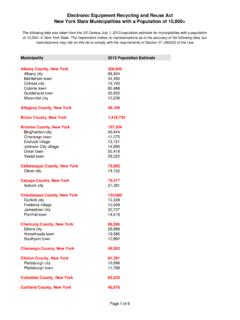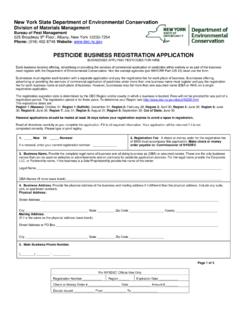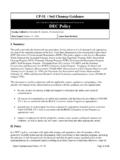Transcription of DEC Program Policy
1 DER-31 / Green Remediation New York State Department of Environmental Conservation DEC Program Policy Issuing Authority: Val Washington Title: Deputy Commissioner Office of Remediation and Materials Management Date Issued: August 11, 2010 Latest Date Revised: January 20, 2011. I. Summary This document identifies the New York State Department of Environmental Conservation (DEC) Division of Environmental Remediation (DER) approach to remediating sites in the context of the larger environment, a concept known as green remediation.
2 AGreen Remediation@ (or greener cleanups) can be defined as the practice of considering all environmental effects of remedy implementation and incorporating options to minimize the environmental footprint of cleanup actions. It is intended to be a holistic approach which improves the overall sustainability of the cleanups by promoting the use of more sustainable practices and technologies. Such practices and technologies are, for example, less disruptive to the environment, generate less waste, increase reuse and recycling, and emit fewer pollutants, including greenhouse gases (GHGs), to the atmosphere.
3 The approach also recognizes the potential for positive economic and social benefits of site reuse and supports coordination of site reuse and remediation to effect the most beneficial and sustainable reuse of the site. This document provides concepts and techniques of green remediation and guidance on how to apply them to DER=s remedial programs, but does not specify methods or criteria to be used to quantify the effectiveness of the various green remediation concepts or remedial alternatives. The concepts will be considered and implemented to the extent feasible, and documented.
4 This Policy applies to all phases of the site cleanup process, from investigation through completion of remediation for sites in the Spill Response Program , Inactive Hazardous Waste Disposal Site Remedial Program (State Superfund Program ), Environmental Restoration Program , Brownfield Cleanup Program , Voluntary Cleanup Program , and the Resource Conservation and Recovery Act (RCRA) Program . II. Policy DER is dedicated to developing and promoting innovative cleanup strategies that restore contaminated sites to productive use, promote environmental stewardship, and reduce associated costs while minimizing ancillary environmental impacts from these cleanups.
5 Applying green remediation concepts, such as minimizing energy consumption, reducing GHG emissions, maximizing the reuse of land and the recycling of materials, and conserving natural resources such as soil, water and habitat helps to achieve that objective. Green remediation concepts will be applied to the existing (ongoing) cleanups and future cleanup of contaminated properties. This Policy does not modify or replace existing remedial Program goals. It is also not intended to encourage, and does not justify, implementation of a Ano action@ or lesser remedy when a more comprehensive remedy is called for, appropriate, and feasible.
6 The priority remains implementing remedies that are protective of public health and the environment. Final Program Policy DER-31 Page 1 of 9. DER remains committed to implementing protective remedies in each Program . Applying green and sustainable principles and technologies to each Program , consistent with each Program 's enabling legislation and regulations, will increase the long term effectiveness, permanence and cost effectiveness of the cleanups and will minimize the overall environmental footprint of remediation.
7 Consistent with existing laws, including Environmental Conservation Law (ECL) Articles 1 and 3, regulations, DEC Policy and with the growing national trend, this Policy establishes an expectation (Section V) for proactive consideration and/or application of green remediation techniques to all phases of work in existing and future cleanups. The procedures set forth in this Policy document are intended for the use and guidance of both DEC staff and remedial parties. They are not intended to create any substantive or procedural rights enforceable by any party in administrative or judicial litigation with DEC.
8 DEC reserves the right to act at variance with these procedures to address site-specific circumstances and to change them at any time. III. Purpose and Background Remediation clearly benefits the environment at and near the site by making the site protective of public health and the environment and by reducing or eliminating localized contamination. There is an environmental footprint (footprint), however, inherent in remediating sites. A remedy may, for example, require significant energy and material use, and contribute emissions of carbon dioxide (CO 2 ) and other GHGs to the atmosphere.
9 It can also impact, for example, land use and aquifer recharge. This footprint can extend beyond the site property lines and even beyond adjacent properties to the larger environment. The larger environment may include, for example, the atmosphere at a significant distance from the site due to the emissions from power generation which provides electricity to operate remedial equipment. Decisions made during the course of planning and implementing the investigation and remediation impact the footprint of the cleanup.
10 Cleanup of our sites must be considered in a larger context, as demanded by issues such as GHG emissions and climate impacts, sprawl, and the effects of energy generation and use. Increasingly, cleanup programs across the nation are considering remedial activities that minimize ancillary environmental impacts by minimizing energy consumption, conserving natural resources, maximizing the reuse of land and recycling of materials. As cleanup technologies and incentives continue to evolve, green remediation strategies offer significant potential for increasing the net benefit of cleanup, cost savings, and the universe of long-term property reuse options without compromising cleanup goals.


